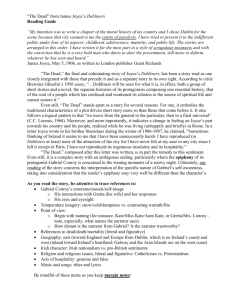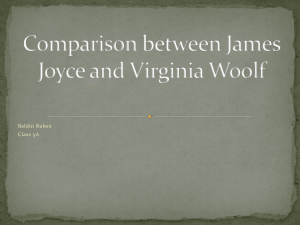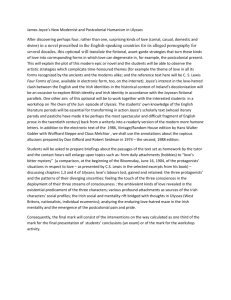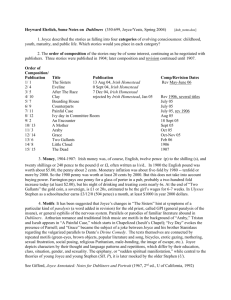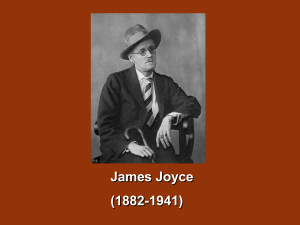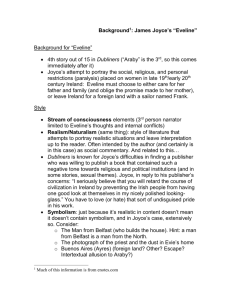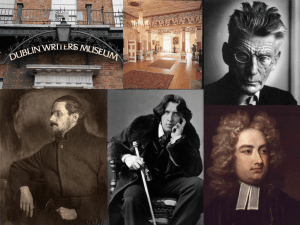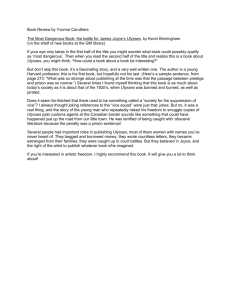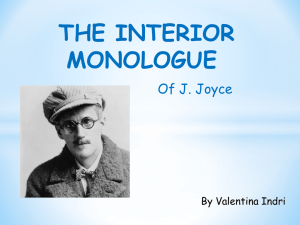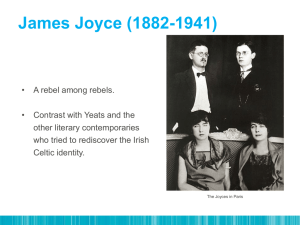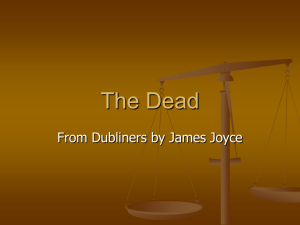JAMES JOYCE AND THE NEW REALISM
advertisement
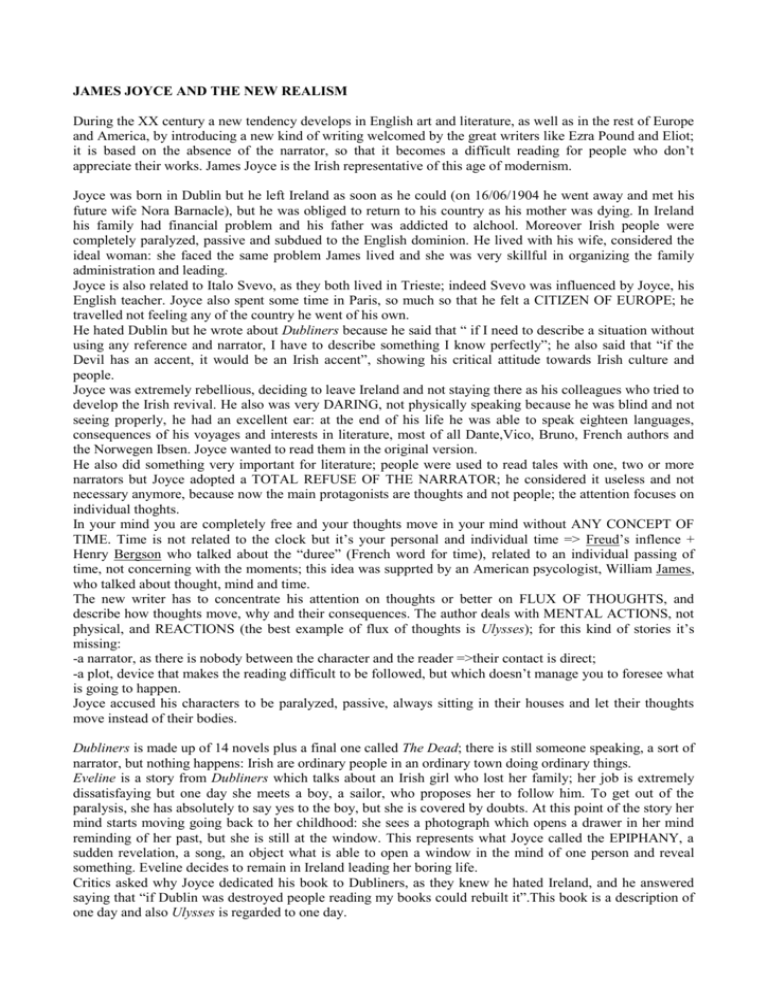
JAMES JOYCE AND THE NEW REALISM During the XX century a new tendency develops in English art and literature, as well as in the rest of Europe and America, by introducing a new kind of writing welcomed by the great writers like Ezra Pound and Eliot; it is based on the absence of the narrator, so that it becomes a difficult reading for people who don’t appreciate their works. James Joyce is the Irish representative of this age of modernism. Joyce was born in Dublin but he left Ireland as soon as he could (on 16/06/1904 he went away and met his future wife Nora Barnacle), but he was obliged to return to his country as his mother was dying. In Ireland his family had financial problem and his father was addicted to alchool. Moreover Irish people were completely paralyzed, passive and subdued to the English dominion. He lived with his wife, considered the ideal woman: she faced the same problem James lived and she was very skillful in organizing the family administration and leading. Joyce is also related to Italo Svevo, as they both lived in Trieste; indeed Svevo was influenced by Joyce, his English teacher. Joyce also spent some time in Paris, so much so that he felt a CITIZEN OF EUROPE; he travelled not feeling any of the country he went of his own. He hated Dublin but he wrote about Dubliners because he said that “ if I need to describe a situation without using any reference and narrator, I have to describe something I know perfectly”; he also said that “if the Devil has an accent, it would be an Irish accent”, showing his critical attitude towards Irish culture and people. Joyce was extremely rebellious, deciding to leave Ireland and not staying there as his colleagues who tried to develop the Irish revival. He also was very DARING, not physically speaking because he was blind and not seeing properly, he had an excellent ear: at the end of his life he was able to speak eighteen languages, consequences of his voyages and interests in literature, most of all Dante,Vico, Bruno, French authors and the Norwegen Ibsen. Joyce wanted to read them in the original version. He also did something very important for literature; people were used to read tales with one, two or more narrators but Joyce adopted a TOTAL REFUSE OF THE NARRATOR; he considered it useless and not necessary anymore, because now the main protagonists are thoughts and not people; the attention focuses on individual thoghts. In your mind you are completely free and your thoughts move in your mind without ANY CONCEPT OF TIME. Time is not related to the clock but it’s your personal and individual time => Freud’s inflence + Henry Bergson who talked about the “duree” (French word for time), related to an individual passing of time, not concerning with the moments; this idea was supprted by an American psycologist, William James, who talked about thought, mind and time. The new writer has to concentrate his attention on thoughts or better on FLUX OF THOUGHTS, and describe how thoughts move, why and their consequences. The author deals with MENTAL ACTIONS, not physical, and REACTIONS (the best example of flux of thoughts is Ulysses); for this kind of stories it’s missing: -a narrator, as there is nobody between the character and the reader =>their contact is direct; -a plot, device that makes the reading difficult to be followed, but which doesn’t manage you to foresee what is going to happen. Joyce accused his characters to be paralyzed, passive, always sitting in their houses and let their thoughts move instead of their bodies. Dubliners is made up of 14 novels plus a final one called The Dead; there is still someone speaking, a sort of narrator, but nothing happens: Irish are ordinary people in an ordinary town doing ordinary things. Eveline is a story from Dubliners which talks about an Irish girl who lost her family; her job is extremely dissatisfaying but one day she meets a boy, a sailor, who proposes her to follow him. To get out of the paralysis, she has absolutely to say yes to the boy, but she is covered by doubts. At this point of the story her mind starts moving going back to her childhood: she sees a photograph which opens a drawer in her mind reminding of her past, but she is still at the window. This represents what Joyce called the EPIPHANY, a sudden revelation, a song, an object what is able to open a window in the mind of one person and reveal something. Eveline decides to remain in Ireland leading her boring life. Critics asked why Joyce dedicated his book to Dubliners, as they knew he hated Ireland, and he answered saying that “if Dublin was destroyed people reading my books could rebuilt it”.This book is a description of one day and also Ulysses is regarded to one day. This was the STYLE of the beginning of the century, wich wanted no plots and dark, gloomy atmospheres with people surviving and psycological introspection. In Ulysses we have a parallel situation with the Odyssey and its three main characters are Stephen Dedalus, Leopold Bloom (Ulysses) and Molly Bloom (Penelope); Leopold and Molly lost their son and they’re looking for him, so that Leopold decides to leave home and one late night he returns with Stephen; Molly is what is called the flesh, instead Penelope represents the loyalty. Joyce used another tecnique: the STREAM OF COUNSCIOUSNESS, a psychic phenomena,in order to give space to thoughts. The writer needs the INTERIOR MONOLOGUE, usually used in theatres (soliloquies, ex Hamlet “To Be Or Not To Be”) where there is someone talking aloud about his thoughts, feelings and actions; in this case there is an interior monologue and the character is THINKING INSIDE HIMSELF=> this is why you can’t have a narrator.There are 3 kinds of interior monologue: 1)DIRECT interior monologue (used in Ulysses): the thoughts of characters are moving without punctuationexample Molly’s monologue at the end of Ulysses; she is alone with her thoughts; 2)INDIRECT interior monologue (Virginia Woolf used it): there is an introduction, some indication –ex she dreamt, she thought…), so it is easier than the former; 3)EXTREME interior monologue: the character is dreaming and is not completely aware-subconscious –ex Finnegans wake. The interior monologue is the way used by the author to transcript the stream of consciousness. Dubliners We still have someone speaking, so there’s a relation between the reader and this kind of narrator which renders the reading not so difficult. It is made up of 14 short stories plus a final one, The Dead, dedicated to Dublin ordinary people living in an ordinary town doing ordinary things ( he needed to have something he knew perfectly, such as places, dates, names, people- sketches in Dublin). The book is divided into four parts: 1) childhood 2) adolescence 3) nature life 4) public life plus The Dead, the best example of what Joyce called epiphany, the discovery through very small details, which changes the life of the character who starts thinking according to the flashback he had. In The Dead it will be a song and it is dedicated to Dublin people, remaining dead => the dead people are not those who are buried but we are the living dead; it is mostly referred to Irish people, completely useless, leading an insignificant life and not able to choose. Plot:Gabriel is a professor and he is very satisfied of his job while Gretta is his beautiful wife; they are having a party for New Year’s Eve(Xmas)at Julia and Kate place (they are the aunts of Gabriel).Gabriel is selected to carry on the speech for the new year. Gretta listening to a song (epiphany) starts crying as it reminds her of a young man, Michael, who used to sing it and who died for her. One night he stayed under the falling rain singing their song but he became ill and died of tubercolosys. Gretta revealed Gabriel she was crying for melancholy but then she fallen asleep. Gabriel starts thinking that the deads are more important than the living ones because Gretta had never talked him about Michael. Once again we are moving mentally while Gabriel is sitting “leaning on his elbow”.
